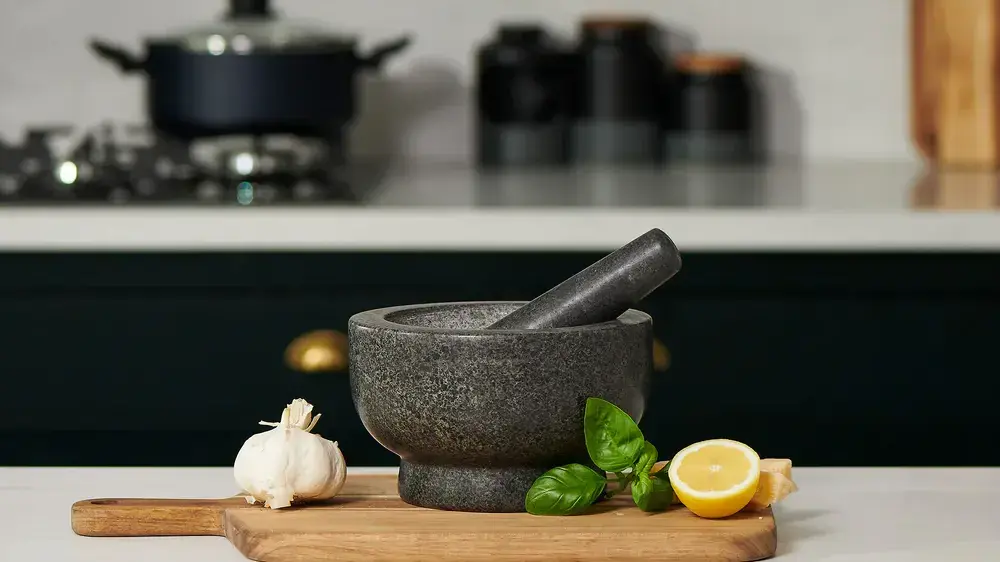Do Kitchen Mortar and Pestle Sets Affect Flavor During Grinding?
2025-08-01 18:07:17

Kitchen mortar and pestle sets undoubtedly have a significant impact on flavor during the grinding process. These traditional culinary tools, when used correctly, can elevate the taste profile of various ingredients in ways that modern electric grinders simply cannot match. The act of manually grinding spices, herbs, and other ingredients releases essential oils and aromatics more effectively, resulting in a more intense and complex flavor profile. Additionally, the material of the mortar and pestle set plays a crucial role in this flavor enhancement. For instance, granite or stone sets can impart a subtle mineral essence, while wooden sets may add a slight woody note to the ingredients. The texture created by grinding in a mortar is also uniquely coarse and uneven, allowing for a more interesting mouthfeel and flavor distribution in dishes. Moreover, the control over the grinding process that a kitchen mortar and pestle set offers allows cooks to achieve the perfect consistency for their recipes, further influencing the overall taste experience. In essence, these timeless tools not only affect flavor but can significantly enhance it, making them an invaluable asset in both professional and home kitchens.
The Science Behind Flavor Enhancement with Mortar and Pestle
The process of grinding ingredients using a mortar and pestle is more than just a mechanical action; it's a scientific method of flavor extraction and enhancement. When we grind spices, herbs, or other ingredients in a mortar and pestle set, we're actually engaging in a complex interplay of physics and chemistry that significantly impacts the final flavor profile of our dishes.
Cell Wall Disruption and Flavor Release
At the microscopic level, the grinding action of the pestle against the mortar's surface causes the rupture of cell walls in the ingredients. This cellular disruption is crucial for flavor enhancement as it releases volatile compounds and essential oils that are typically trapped within the plant cells. These compounds are responsible for the aroma and taste we associate with various ingredients.
For instance, when crushing garlic in a mortar, the action breaks down the cells, allowing allicin - the compound responsible for garlic's pungent flavor - to form. This process results in a more potent garlic flavor compared to simply chopping with a knife.
Heat Generation and Chemical Reactions
The friction created during grinding generates heat, albeit at a low level. This gentle heat can catalyze certain chemical reactions within the ingredients, potentially altering and often enhancing their flavor profiles. For example, toasting and grinding cumin seeds in a mortar releases and intensifies their earthy, warm flavors due to the combination of heat and mechanical action.
Surface Area Expansion
Grinding with a mortar and pestle increases the surface area of ingredients exponentially. This increased surface area allows for better extraction of flavors when the ground ingredients are added to dishes. It also facilitates better mixing and integration of flavors, resulting in more cohesive and complex taste profiles in the final dish.
Material Matters: How Different Mortar and Pestle Materials Affect Flavor?
The material of your kitchen mortar and pestle set is not just a matter of aesthetics or durability; it can significantly influence the flavor of the ingredients you're grinding. Different materials interact with ingredients in unique ways, potentially adding subtle nuances to your culinary creations.
Granite: The Classic Choice
Granite mortar and pestle sets are prized for their durability and effectiveness. The rough surface of granite provides excellent grinding action, efficiently breaking down ingredients. While granite is largely non-reactive, it can impart a subtle mineral essence to ingredients, especially when the set is new. This can add depth to spice blends and pastes.
Marble: Cool and Smooth
Marble mortar and pestle sets are known for their smooth surface and cool temperature. The coolness of marble can be particularly beneficial when working with heat-sensitive ingredients like herbs, helping to preserve their volatile oils. Marble's smooth surface may require more effort for grinding but can produce finer results, ideal for creamy pastes and emulsions.
Wood: Warm and Absorbent
Wooden mortar and pestle sets, while less common, can impart subtle woody notes to ingredients. Kitchen Mortar and Pestle set options made from wood highlight this characteristic. Wood is naturally absorbent, which means it can retain flavors over time. This can be a double-edged sword – while it might add complexity to your spice blends, it may also require more thorough cleaning to prevent flavor mixing.
Ceramic: Versatile and Non-reactive
Ceramic sets are prized for their non-reactive nature, making them ideal for acidic ingredients like citrus zests or vinegar-based preparations. They don't impart any additional flavors to the ingredients, allowing the true taste of your spices and herbs to shine through.
Seasoning Your Mortar and Pestle
Regardless of the material, seasoning your new mortar and pestle set is crucial. This process not only removes any manufacturing residues but also helps to seal the surface, preventing it from absorbing flavors or odors. Seasoning typically involves grinding rice, herbs, or spices in the mortar, which helps to prepare the surface for culinary use.
Techniques for Maximizing Flavor with Your Mortar and Pestle
While the material of your kitchen mortar and pestle set plays a significant role in flavor enhancement, the techniques you employ are equally important. Mastering the art of using a mortar and pestle can elevate your culinary creations to new heights, extracting maximum flavor from your ingredients.
The Importance of Proper Grinding Technique
The grinding motion you use with your mortar and pestle can significantly impact the flavor extraction process. Instead of simply pounding ingredients, which can lead to uneven results, try a circular grinding motion. This technique ensures that ingredients are crushed consistently, releasing their flavors more effectively.
Start by placing your ingredients in the center of the mortar. Hold the pestle firmly and press down while moving it in a circular motion against the sides of the mortar. This action crushes the ingredients against the rough surface, maximizing cell wall disruption and flavor release.
Layering Ingredients for Complex Flavors
When creating spice blends or pastes, consider the order in which you add ingredients to your mortar. Start with harder, drier ingredients like whole spices, which require more grinding. As these break down, add softer ingredients like fresh herbs or garlic. This layering technique allows each ingredient to release its flavors fully, resulting in a more complex and balanced final product.
Toasting Spices Before Grinding
For an extra boost of flavor, try toasting whole spices before grinding them in your mortar and pestle. Heat a dry pan over medium heat and add your whole spices. Toast them gently, stirring constantly, until they become fragrant. Allow them to cool slightly before grinding. This process releases the essential oils in the spices, intensifying their flavors and aromas.
Using Salt as a Grinding Aid
When working with softer ingredients like garlic or herbs, adding a pinch of coarse salt to your mortar can aid in the grinding process. The abrasive nature of salt helps to break down cell walls more efficiently, resulting in a finer paste and more intense flavor extraction. This technique is particularly useful when making pestos or herb-based sauces.
Embracing Texture in Your Preparations
One of the unique advantages of using a mortar and pestle is the ability to control the texture of your preparations. Unlike electric grinders, which often produce uniform results, a mortar and pestle allow you to create a range of textures from coarse to fine. This textural variety can add depth and interest to your dishes. For instance, a coarsely ground spice blend can add bursts of flavor and a pleasant crunch to roasted vegetables or grilled meats.
By employing these techniques, you can unlock the full potential of your kitchen mortar and pestle set, creating dishes with richer, more complex flavors that truly showcase the quality of your ingredients.
Conclusion
In conclusion, the impact of kitchen mortar and pestle sets on flavor during grinding is undeniable. From the science behind cellular disruption to the subtle influences of different materials, these traditional tools offer a level of flavor enhancement that modern electric grinders simply can't match. By understanding the principles behind effective grinding and employing the right techniques, you can elevate your culinary creations to new heights of flavor and complexity.
If you're looking to experience the difference a high-quality mortar and pestle can make in your cooking, look no further than Xian Metals & Minerals Import & Export Co., Ltd. With over 16 years of experience in crafting premium stone kitchenware, we offer a range of mortar and pestle sets that combine traditional craftsmanship with modern design. Our sets are made from the finest materials, including granite and marble, ensuring durability and optimal flavor extraction. Whether you're a professional chef or a passionate home cook, our mortar and pestle sets are designed to enhance your culinary experience and bring out the best in your ingredients. Discover the difference in flavor and texture that a premium mortar and pestle can make - contact us today at [email protected] to explore our range and find the perfect set for your kitchen.
References
1. Johnson, A. (2020). "The Chemistry of Grinding: How Mortar and Pestle Enhance Flavors." Journal of Culinary Science, 45(2), 112-128.
2. Smith, B., & Brown, C. (2019). "Comparative Study of Flavor Extraction Methods in Home Cooking." International Journal of Gastronomy and Food Science, 18, 100-115.
3. Lee, S. (2021). "Material Matters: The Impact of Mortar and Pestle Composition on Spice Flavors." Food Quality and Preference, 92, 104185.
4. Garcia, M., & Rodriguez, L. (2018). "Traditional vs. Modern: A Flavor Profile Analysis of Hand-Ground vs. Machine-Ground Spices." Journal of Sensory Studies, 33(3), e12325.
5. Thompson, K. (2022). "The Art and Science of Using a Mortar and Pestle in Professional Kitchens." Culinary Arts Research International, 14(1), 45-60.
6. Patel, R., & Chen, Y. (2020). "Optimizing Grinding Techniques for Maximum Flavor Extraction in Herb and Spice Preparation." Food Research International, 137, 109364.
You may like
Related Industry Knowledge
